
Today we see such forms as the "Tazzas" above, and likely think "Cake Stand!"
Well, almost...but not quite.
So here’s the story....partially.
The word "tazza" is "cup" in Italian, referring specifically to
a shallow wide cup raised on a short stem and wide base...
the base sometimes turned upside down, doubling for small bits of food.
Other European spellings that may be familiar :
German : tasse
French : tasse
Spanish : taza
Portuguese : taça
(Perhaps think "demitasse". Plurals, tazza, tazzas or tazze).

Above is such an early Italian "tazza", held by "The Cup Bearer",
from Paolo Veronese's painting "Wedding Feast at Cana" (1563),
the most expansive picture in the painting collection at the Louvre, Paris.
Note the "cup" appears as a small "shallow dish on a stem".
These drinking "cups" soon grew to be important "elevated dishes" -
also known as tazzas (tazze),
creating additional space on oft-over-crowded "grazed"* tables of the day
.These Continental Renaissance period tazzas were constructed from varying materials -
metals, ceramics, glass, even shells -
and usually quite elaborately decorated.
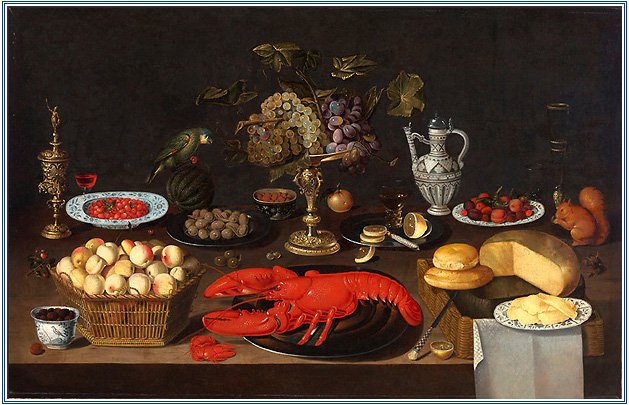
And they housed anything and everything - from small desserts - to fruits - to flowers.
Further - if the art of the period is any indicator - tazzas quickly became favorite subjects of
painters - particularly the Dutch...
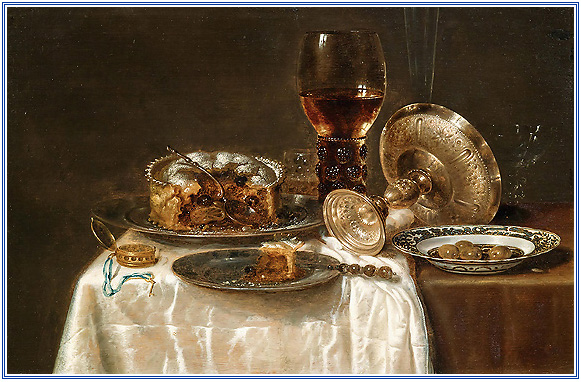
...who often seemed to favor them in "inverted" positions,
presumably for both composition, and depicting tazzas' very fanciful decorations.
Early tazzas were quite expensive - thus part of only wealthy households.
And there is no question that the elevated tazza made all contents appear
even more important - and appealing -
(and perhaps a bit closer to the nibbling hand).
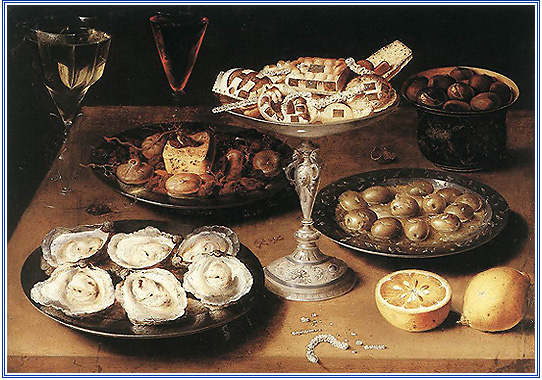
Do note : the Continental 16th and 17th century tazzas continue in a shallow "dished" shape.
But SLIGHTLY DIFFERENT are the "BRITISH TAZZAS"
During mid-17th century, tazzas with flatter surfaces emerged into British fashion.
Unlike the highly decorative Continental (European) tazzas,
these tazzas took a more "utilitarian" form -
a "lower pedestal foot", a "plainer surface", and sometimes only a simple banded rim.
Due to the plate-like surface, British glass tazzas are also referred to as "footed salvers".
Similarly, silver tazzas are also referred to as "salver on stand",**
the silver in reference only to the 17th-early 18th century "silver salver on a central foot".
17th century Britain also produced elaborate low footed salvers -
some with grandiose embossing, some ( as below) with finely executed Chinoiserie chasing :
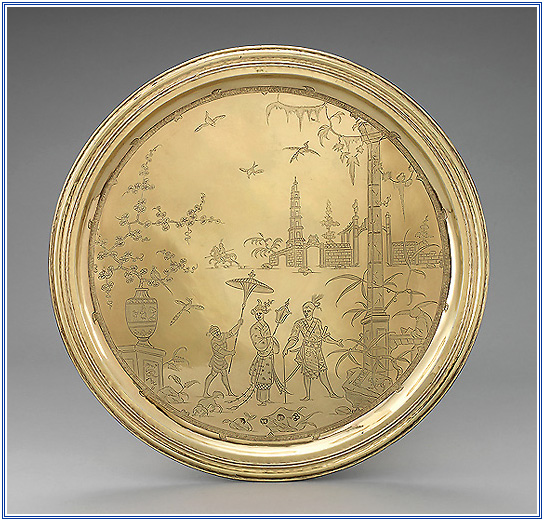
(Metropolitan Museum / Thomas Jenkins, 1682-3 / 2.5" High x 7.25" Wide )
Below is a George IV silver-gilt slightly dished tazza in the17th century British manner,
sold by this gallery a few years ago (Robert Garrard, London, 1829) :
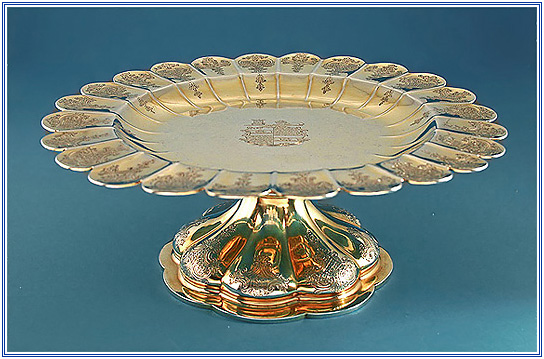
"THE 18TH CENTURY BRITISH TAZZA"
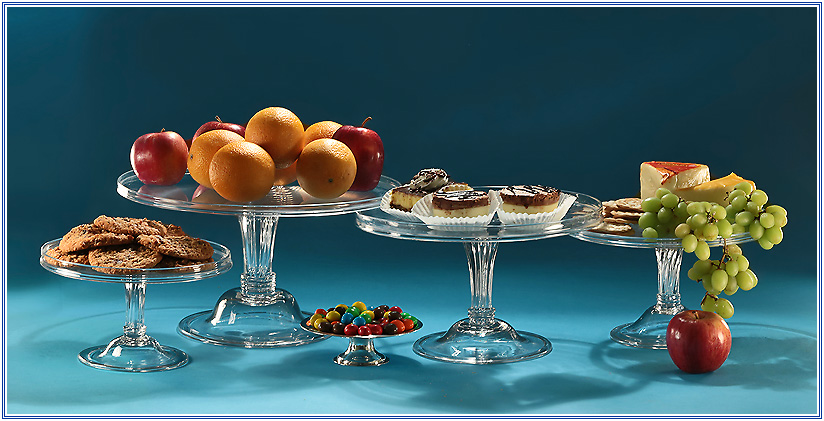
As did the 17th century examples, 18th century British tazzas served a great variety of functions :
very small ones for the "lady's toilette" (face "patches" for instance);
"service", as the fashion held that attendants remain at a distance;***
holding variety of "confections";
displaying carefully "arranged fruits";
graduated sets of tazzas holding foods -
particularly "dessert" - or other "glasses" -
including "syllabub glasses" (a sweet wine and whipped cream drink) -
or possibly champagne glasses.****
Regardless of purpose, tazzas would make even the simplest service, or table setting,
appear elegant, grand,
and all their contents both more appealing and important.
Below are FIVE "18TH CENTURY BRITISH TAZZAS" from our stock,
to enhance your festive table - or your humble kitchen counter -
beit for corner-store doughnuts, M&M's, or your finest fruit and pastries.
The first,
A 1720 SILVER TAZZA : ...
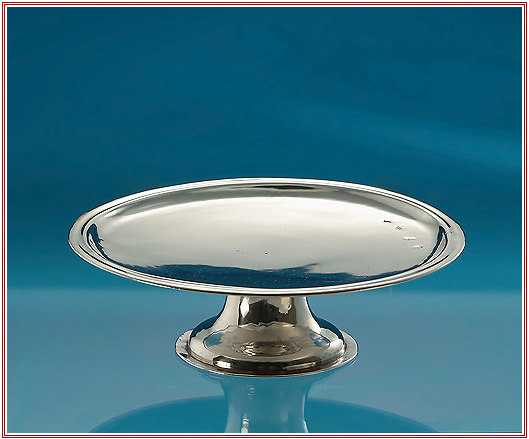
GEORGE I SILVER TAZZA (SALVER on STAND)
Of simple rounded form with raised rim and flaring foot
London, 1720, Maker’s Marks Rubbed,
Possibly Hugh Arnett & Edward Pocock
5.75” Diameter x 1.75” High / 5.1 oz.
and FOUR 18th CENTURY GLASS TAZZAS : ...
British GLASS TAZZAS date (rarely) to the late 17th century.
Below, now in the Metropolitan Museum, NYC,
is a very rare c1670 tazza from the Buckingham Glassworks, Greenwich,
in the Venetian dished manner - as the "cup" in the 1563 "Wedding Feast at Cana" (shown above).
Immigrant Venetian glassmakers had been brought to England by
George Villiers, second Duke of Buckingham, to produce this delicate glass :
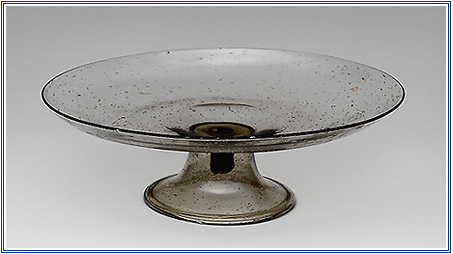
(Metropolitan Museum / 2.5" High x 7.25" Wide )
However, the majority of British glass tazzas date mid-to late 18th century,
and follow a rather specific form :
flat, with a simple rim, raised on a pedestal - usually moulded (Silesian),
the broad round foot folded and often domed.
Below are 4 glass tazzas (from our stock),
ranging 13.75" wide, down to 8.75".
All are in remarkable condition and with only slight differences.
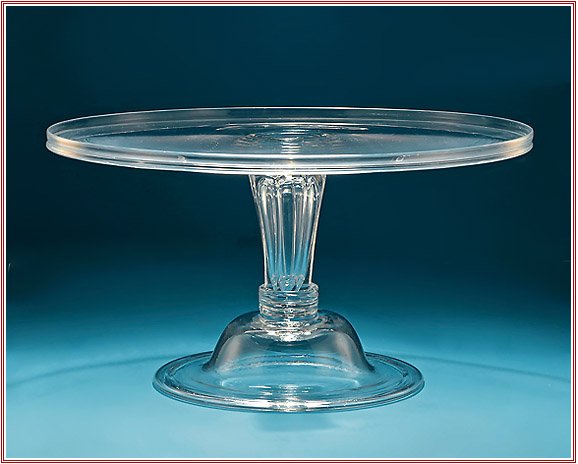
RARE GEORGE III LARGE GLASS TAZZA with MOULDED PEDESTAL STEM
England, Mid-Late 18th Century
Having a moulded teared pedestal with four basal collars, domed folded foot
13.75" Wide, 7.25" High, 7.5” Wide, the Foot / 71 oz.
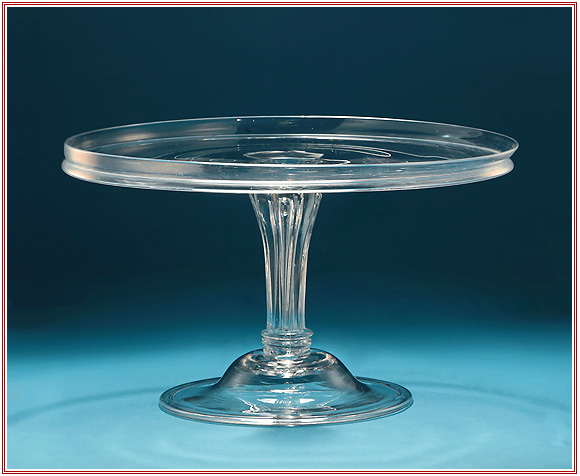
GEORGE III GLASS TAZZA with MOULDED PEDESTAL STEM
England, Mid-Late 18th Century
Having a moulded teared pedestal with two basal collars, domed folded foot
11.5" Wide, 6.75" High, 6.5" Wide, the Foot / 45.8 oz.
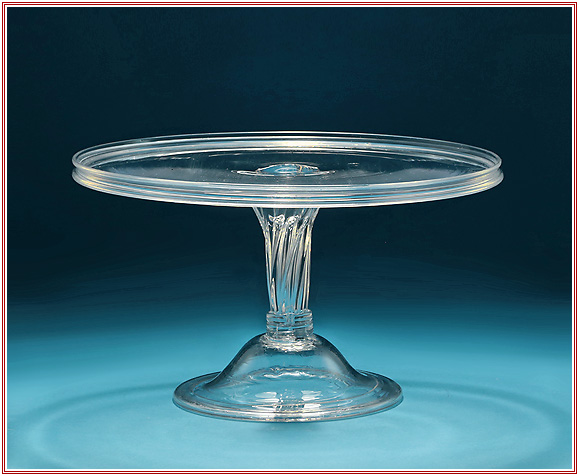
GEORGE III GLASS TAZZA with MOULDED PEDESTAL STEM
England, Mid-Late 18th Century
Having a moulded teared pedestal with a "twist" and two basal collars, domed folded foot
10.25" Wide, 5.75" High, 5.5" the Wide, the Foot / 34.2 oz.
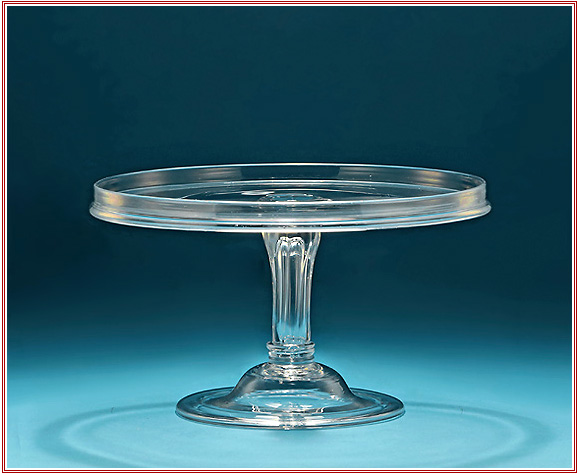
GEORGE III GLASS TAZZA with MOULDED PEDESTAL STEM
England, Mid-Late 18th Century
Having a moulded teared pedestal with rounded shoulders and 2 basal collars,
domed folded foot
8.75" Wide, 5" High, 5" Wide, the Foot / 23 oz.
"Dessert Course, Viscount Fairfax, c1760",
an accurate recreation with 'stacked' fruit-filled tazzas : *****
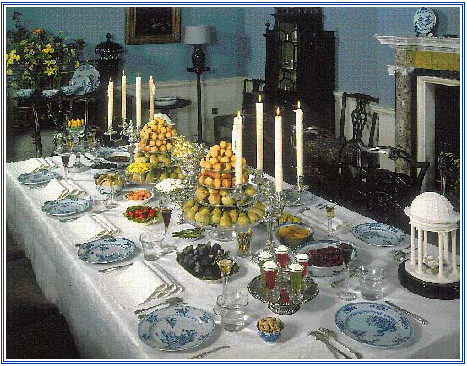
An Aside : The traditional method of making anything seem more important is, of course,
to elevate it.
Consider royal thrones, church pulpits, Olympic winner's platforms...the list goes on.
And the possibilities limitless!
SOME INTERESTING FOOTNOTES :
* 17th and early 18th century banquet or dessert tables were often
"grazed",
either without seating, or with a few chairs and stools.
** The familiar
flat salver (or waiter) on small feet at the edge appeared about 1720, or slightly before.
*** Pietro Longhi,
"Lady at her Toilette", 1755-60, Ca' Rezzonico, Museo del Settecento, Venice,
(the toiletries brought by an attendant, on a flat silver tazza (salver on stand) :
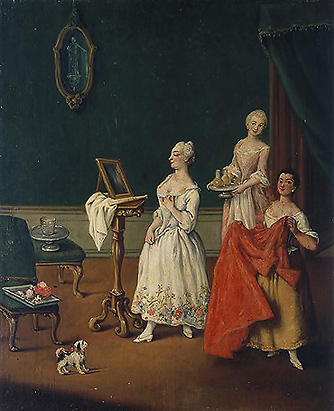
**** Although suggested, the serving of
champagne from a tazza is deemed "incorrect"
by wine connoisseurs, as it should be poured directly from the bottle.
*****"Dessert Course, Viscount Fairfax,
c1760",
an accurate recreation :
"In 1763, Fairfax held a party for 18 people to celebrate the completion of his magnificent York townhouse.
The invoice for the dessert course shows he paid a staggering 16 pounds to the city chef William Baker
for
five pyramids of wet and dry sweetmeats, which included the rental of the glass and other structures
necessary for the display of this extravaganza. Monsieur Seguin, a French confectioner and longtime
resident of York, supplied the various sweetmeats."
(From an article by Sarah Nichols for the Carnegie Museum -
'At Table : High Style in the 18th Century'; the image "British Cutlery", Peter Brown, p. 49)
Charles II Silver-Gilt Tazza, Thomas Jenkins, London, 1682-3, (profile image below)
with finely chased figures in a Chinese landscape, Metropolitan Museum, NYC :
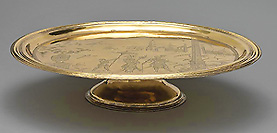
Charles II Glass Tazza, c1665-70, Attr. Glasshouse, Duke of Buckingham,
Metropolitan Museum, NYC
(The "cake stand" is a late Victorian relative of the tazza, coming into fashion with afternoon tea.
Presenting the cake at a higher level gave the cake, as before, more attention and importance.
Other relatives are the dished "comport" and "compote", the latter of 19th and 20th centuries.)
PAINTINGS IN ORDER SHOWN (public domain) :
"Wedding Feast at Cana", Paolo Veronese, (1563), Louvre, Paris :
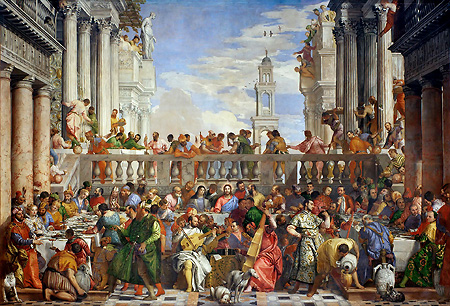
From 1563 to 1767, this 30-foot long High Renaissance Mannerist style masterpiece
decorated the refectory of the church of San Giorgio Maggiore, Venice.
This important work contains more than 130 famous personalities of the day, including :
Eleanor of Austria, Emperor Charles V, Mary of England, and Vittoria Colonna, Marchioness of Pescara.
It was looted as war booty by Napoleon's armies in 1767, cut in half, and taken to France,
and stored in the Louvre. During the late 19th century Franco-Prussian war, the painting was
boxed and stored in Brest. During World War II, the then 382-year-old painting was once again
rolled up for storage, continually being transported to hiding places throughout the south of France.
In 1989, the painting began its much needed restoration - during which if suffered further damages.
However, after a 3-year restoration, "Wedding Feast at Cana" has regained the original force
and brilliance of color, and hangs opposite the "Mona Lisa" in the Louvre.
"Still Life of Fruit, a Lobster, Cheeses and Drinking Vessels with a Parrot and a Squirrel on a Table",
Artus Claessens, between 1625 and 1644, Oil on Canvas, Museum of Fine Arts, Budapest
(Parrots and squirrels are frequently shown in paintings from the Renaissance period,
as both were rather special pets).
"Olives in a Blue and White Porcelain Bowl, a Roemer, Wine Glasses,
An Overturned Silver Tazza and a Meat Pie", Willem Claesz Heda, 1650s, Oil on Panel, Private Collection
"Still Life with Oysters and Pastries", Osias Beert, 1610, Oil on Copper, Staatsgalerie, Stuttgart
“Lady at her Toilette””,0Pietro Longhi, 1755-60, Ca’ Rezzonico, Museo del Settecento, Venice
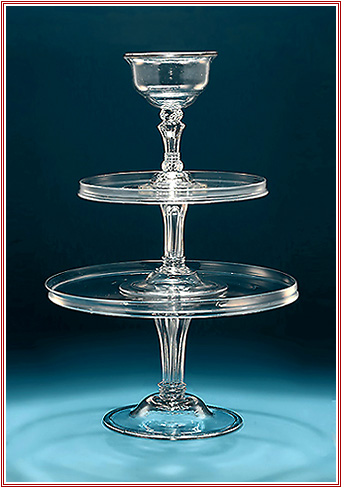
Inventory Photography : Millicent F. Creech
|